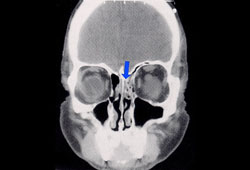嗅觉丧失与很多疾病有关,有时极度影响患者生活质量。
流行病学
据估计,嗅觉丧失在一般成年人中的发生率在19%(20岁以上人群)到25%(50岁以上人群的)之间。[1]Bramerson A, Johansson L, Ek L, et al. Prevalence of olfactory dysfunction: the Skovde population-based study. Laryngoscope. 2004 Apr;114(4):733-7.
http://www.ncbi.nlm.nih.gov/pubmed/15064632?tool=bestpractice.com
[2]Murphy C, Schubert CR, Cruickshanks KJ, et al. Prevalence of olfactory impairment in older adults. JAMA. 2002 Nov 13;288(8):2307-12.
http://www.ncbi.nlm.nih.gov/pubmed/12425708?tool=bestpractice.com
[3]Hoffman HJ, Ishii EK, MacTurk RH. Age-related changes in the prevalence of smell / taste problems among the United States adult population: results of the 1994 disability supplement to the National Health Interview Survey. Ann NY Acad Sci. 1998 Nov 30;855:716-22.
http://www.ncbi.nlm.nih.gov/pubmed/9929676?tool=bestpractice.com
患病率与年龄和男性正相关,80 岁以上人群的患病率可高达 63%。[2]Murphy C, Schubert CR, Cruickshanks KJ, et al. Prevalence of olfactory impairment in older adults. JAMA. 2002 Nov 13;288(8):2307-12.
http://www.ncbi.nlm.nih.gov/pubmed/12425708?tool=bestpractice.com
在美国老年人(平均年龄 68 岁)的横断面研究样本中,当使用经验证的气味识别方法时,大约 22% 的人无法识别 4 种或更多种气味。[4]Pinto JM, Schumm LP, Wroblewski KE, et al. Racial disparities in olfactory loss among older adults in the United States. J Gerontol A Biol Sci Med Sci. 2014 Mar;69(3):323-9.
https://www.doi.org/10.1093/gerona/glt063
http://www.ncbi.nlm.nih.gov/pubmed/23689829?tool=bestpractice.com
非洲裔美国老年人和西班牙裔老年人更可能出现嗅觉功能障碍。[4]Pinto JM, Schumm LP, Wroblewski KE, et al. Racial disparities in olfactory loss among older adults in the United States. J Gerontol A Biol Sci Med Sci. 2014 Mar;69(3):323-9.
https://www.doi.org/10.1093/gerona/glt063
http://www.ncbi.nlm.nih.gov/pubmed/23689829?tool=bestpractice.com
病因
原发性嗅觉丧失的患者中,最常见的病因包括上呼吸道病毒感染、头外伤和隐匿性慢性鼻窦炎病史。[5]Deems DA, Doty RL, Settle RG, et al. Smell and taste disorders, a study of 750 patients from the University of Pennsylvania Smell and Taste Center. Arch Otolaryngol Head Neck Surg. 1991;117:519-528.
http://www.ncbi.nlm.nih.gov/pubmed/2021470?tool=bestpractice.com
[6]Seiden AM, Duncan HJ. The diagnosis of a conductive olfactory loss. Laryngoscope. 2001 Jan;111(1):9-14.
http://www.ncbi.nlm.nih.gov/pubmed/11192906?tool=bestpractice.com
[7]Hoekman PK, Houlton JJ, Seiden AM. The utility of magnetic resonance imaging in the diagnostic evaluation of idiopathic olfactory loss. Laryngoscope. 2014 Feb;124(2):365-8.
http://www.ncbi.nlm.nih.gov/pubmed/23775878?tool=bestpractice.com
这三大病因在患者中占到50%。
病理生理学
嗅觉丧失可以是感觉神经性缺失,继发于嗅裂嗅觉神经感受器或神经上皮的退行性变。[8]Jafek BW, Hartman L, Eller PM, et al. Postviral olfactory dysfunction. Am J Rhinol. 1990 May;4(3):91-100. 它也可以是由于鼻腔阻塞或炎症妨碍味素传导至嗅觉感受器导致的传导性的嗅觉丧失。
嗅觉丧失分型
嗅觉丧失可以是完全的(失嗅)或部分(嗅觉减退)。 对所接受气味失去辨别能力(嗅觉障碍)可以是由于环境中某些味素刺激引起(嗅觉倒错)或自发产生(幻嗅)。
临床表现
患者常抱怨嗅觉和味觉同时丧失或仅丧失嗅觉,但是调查发现味觉功能是完整的。 这与人们日常对味觉和嗅觉的混淆有关。 味觉包括咸、酸、甜、苦、辣。[9]Lindemann B, Ogiwara Y, Ninomiya Y. The discovery of umami. Chem Senses. 2002 Nov;27(9):843-4. 味觉基于嗅觉、触觉、温度觉和味觉,这其中嗅觉被认为是最重要的感觉。 失去嗅觉刺激后,食物不再那么有吸引力了,大多数患者很快就意识到这一点; 但真正可评估的味觉丧失并不多见。[5]Deems DA, Doty RL, Settle RG, et al. Smell and taste disorders, a study of 750 patients from the University of Pennsylvania Smell and Taste Center. Arch Otolaryngol Head Neck Surg. 1991;117:519-528.
http://www.ncbi.nlm.nih.gov/pubmed/2021470?tool=bestpractice.com
治疗
确定是否是由于炎症导致的嗅觉丧失很重要,因为只有在这种情况下治疗才是有效的。 不幸的是,对于大多数嗅觉丧失的患者并没有有效的治疗方案。 然而,患者会继续寻求医学帮助,直到他们认为所有的诊断性检查都做了,并得到一个详尽的解释。[10]Harris R, Davidson TM, Murphy C, et al. Clinical evaluation and symptoms of chemosensory impairment: 1000 consecutive cases from the nasal dysfunction clinic in San Diego. Am J Rhinol. 2006 Jan-Feb;20(1):101-8.
http://www.ncbi.nlm.nih.gov/pubmed/16539304?tool=bestpractice.com
有些数据提示,嗅觉训练可增加病毒感染后或外伤后嗅觉丧失的恢复可能性。[11]Konstantinidis I, Tsakiropoulou E, Bekiaridou P, et al. Use of olfactory training in post-traumatic and postinfectious olfactory dysfunction. Laryngoscope. 2013 Dec;123(12):E85-90.[12]Pekala K, Chandra RK, Turner JH. Efficacy of olfactory training in patients with olfactory loss: a systematic review and meta-analysis. Int Forum Allergy Rhinol. 2016 Mar;6(3):299-307.
https://www.doi.org/10.1002/alr.21669
http://www.ncbi.nlm.nih.gov/pubmed/26624966?tool=bestpractice.com
后遗症
嗅觉丧失所导致的安全问题包括无法辨别毒气泄露、火及变质的食物。 然而,嗅觉丧失对患者最大的影响莫过于在吃喝方面导致的生活质量下降。 这可以是毁灭性的。 在有的患者中可能导致胃口不好及营养摄入不足,而在另一些患者中则可能为了追求化学刺激的满足而暴饮暴食体重增长。 这些情况可负面影响基础疾病,如糖尿病和高血压。 这些患者却总是得不到朋友和家人甚至是自己医生的同情和理解。
对于多数嗅觉丧失的患者,一般没有可恢复嗅觉的治疗方法(除非嗅觉丧失继发于炎症性鼻窦炎)。因此,虽然很多患者确实可获益于有关安全问题和增味方法的咨询,但是任何关于预后的信息都变得至关重要。研究表明,相较于感音神经受损的病因,预后与初始嗅觉丧失的严重程度、年龄、患者性别、是否吸烟及是否有嗅觉障碍更具相关性。[13]Hummel T, Lötsch J. Prognostic factors of olfactory dysfunction. Arch Otolaryngol Head Neck Surg. 2010 Apr;136(4):347-51.
http://archotol.jamanetwork.com/article.aspx?articleid=496192
http://www.ncbi.nlm.nih.gov/pubmed/20403850?tool=bestpractice.com
[14]London B, Nabet B, Fisher AR, et al. Predictors of prognosis in patients with olfactory disturbance. Ann Neurol. 2008 Feb;63(2):159-66.
https://www.doi.org/10.1002/ana.21293
http://www.ncbi.nlm.nih.gov/pubmed/18058814?tool=bestpractice.com


登录或订阅即可浏览 BMJ Best Practice 临床实践完整内容